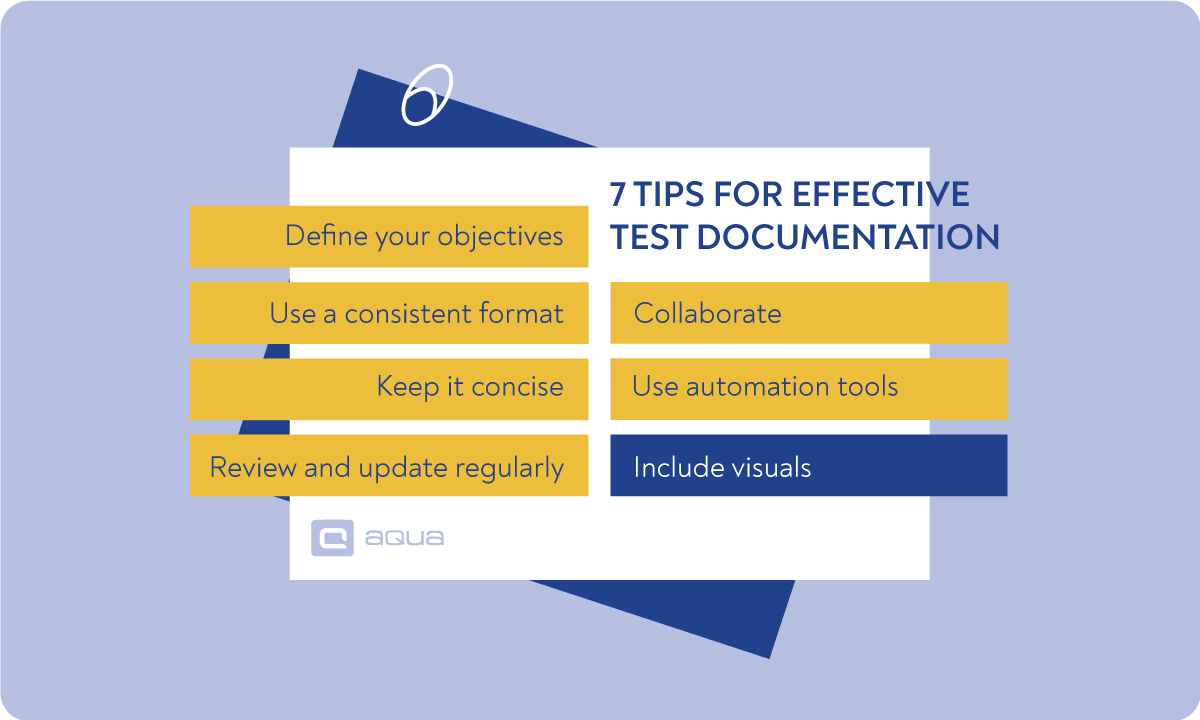Before you start to panic because of poor documentation and think that all your team’s efforts have been for nothing, stop there for a moment. Do not worry. By implementing effective documentation strategies, you can regain control of your testing process and ensure that nothing slips through the cracks. In this article, we will explore seven tips for enhancing your test documentation, enabling your team to succeed and overcoming this setback. So, let’s dive in and revolutionise your software testing practices!
What is test documentation?
Test documentation is creating and maintaining documents that record the planning, design, execution, and results of software testing. Want complete test coverage? Your documentation needs to hit these essentials: test plans, strategies, requirement matrices, cases, data specs, bug reports, and execution logs. Think of it as your testing GPS – without it, teams wander off-track nearly 40% more often. Accurate test documentation is a crucial part of any software development project: it reduces errors, improves communication, and ensures your software testing efforts are well-crafted and repeatable. Let’s dive into how you can create effective test documentation in software testing with seven simple, actionable tips.
"Incorrect documentation is often worse than no documentation"
Types of Test Documentation: Essential Documents Every Team Needs
Getting solid test coverage means you need the right documents in place – and there’s more to it than just basic test plans. Your team should focus on five key document types that actually move the needle. Start with Test Strategies for your big-picture approach and risk management, then build out Requirement Traceability Matrices to map what you’re testing back to original requirements.
Don’t skip Test Data sheets either – they specify all your inputs and boundary values so anyone can recreate tests consistently. Test Execution Reports give you those crucial summaries of what happened during test runs, while Version Control records keep everything organized as things change. Here’s the thing most teams miss: companies using comprehensive test documentation see defect escape rates drop by nearly half compared to those winging it with scattered notes.
Start with just the Traceability Matrix if you’re overwhelmed. Map your current tests to requirements first, then expand from there. These documents create shared understanding across your whole team and make compliance audits a breeze instead of a nightmare.

#1. Define your objectives
When you want to go on a vacation, you usually have a destination in mind, right? Well, the same principle applies to software testing documents. While exploratory testing can be a great way to uncover new issues and improve your testing process, it’s important not to forget the importance of well-documented testing procedures. Think about it — how are your current and future colleagues supposed to join you on the testing journey if they don’t know where you’re going? By developing and maintaining clear testing documentation, you can ensure that your team is aligned, your processes are well-documented, and your software is of high quality.
Our first test documentation tip: define clear objectives. This will set your team up to work toward a certain, realistic goal and will keep you focused. Here are some tips on how to do it:
- Identify the purpose of your testing: Will you test for usability, security, functionality, or something else?
- Determine the scope: What test types will you be conducting? What areas will you cover?
- Establish a clear goal for each test: What are your expectations and hopes with each test?
- Use metrics to track progress: How will you measure success? How will you know if your testing teams did good, keeping your testing project at a high level?
#2. Use a consistent format in your testing documents
To read test documents that are poorly formatted and difficult to follow is a frustrating and time-consuming process. That is why it is crucial to maintain consistency when you create test documentation. This does not only apply to test documentation efforts but to all the testing activities. Below are some steps you can implement to use a consistent format in your documents:
- Choose a standardised format for your document and keep it consistent across all your documents.
- Label and organise each section of your documents so it is easy to navigate and find the needed information.
- Use a consistent naming convention for your documents, which makes it easy to identify and keep track of them over time.
- Use stable terminology so everyone on your team uses the same language and understands the concepts.
- Insert tables, headings, and lists into your documentation to ensure it is easy to read and skim.
Managing test documentation across multiple projects can be overwhelming. However, aqua cloud supercharges your QA efforts as a centralised repository for all your activities, both manual and automated. Enjoy 100% visibility and traceability across test cases, requirements, and defects. With AI-powered generation, create test cases and requirements in under 2 minutes, saving you 97% of your time. Real-time collaboration and version control ensure your team works cohesively, eliminating overlaps. Receive KPI alerts to stay on top of critical metrics. The seamless integration with Capture enables effortless bug reporting and enhances your testing workflow. Supercharge your QA efforts with aqua cloud and maintain consistent, comprehensive documentation with ease.
Keep your documentation neat with a 100% traceable, transparent QA management tool
#3. Keep it concise
Our next test documentation advice: keep it clear and direct. In the software testing process, you should avoid including excessive information that can distract or confuse your team. Here are some tips to keep your documentation concise:
- Use simple, clear language: Ensure that your documentation is written in a way that is easily understandable by avoiding excessive jargon or complex terminology where possible to lower the barrier of entry for new specialists.
- Focus on the most important information: Include test objectives, scope, requirements, test cases and test data, and milestones to ensure you cover the most critical aspects of testing.
- Use short sentences and bullet points: Break down complex information into concise and digestible chunks for better comprehension.
- Highlight key information: Use formatting techniques such as bolding, italicising, or colour coding to emphasise critical information to draw attention to crucial details, making your test summary report even better.
- Avoid repetition or duplication: Review your documentation carefully to ensure that you don’t repeat the same information unnecessarily.
- Have someone else review your documentation: Seek feedback from a fresh set of eyes by having an experienced team member review your documentation. This person should be able to provide valuable insights and point out areas that may require further clarification or improvement.
#4. Review and update your test documentation regularly
Here’s the thing about test documentation – it dies the moment you treat it like a “set it and forget it” task. Instead, wire those updates directly into your workflow triggers. Every time requirements shift, features drop, or bugs get squashed, your docs should automatically land on someone’s to-do list. Throw documentation updates right into your Definition of Done checklist. Teams that do this see their doc accuracy rates nearly double within months. Pick one trigger that happens most often in your cycle and attach a 10-minute doc review to it. You’ll be shocked how this small habit keeps everything current without the usual documentation debt piling up.
Make sure to schedule regular reviews and updates and involve your team in the process to ensure that everyone from the development team and QA team is on the same page. Consider these steps to keep your test documentation up-to-date:
- Frequency of reviews: Determine the appropriate frequency for reviewing the test documentation. For longer projects, it is better to schedule reviews on a monthly or bi-monthly basis. For shorter ones, weekly or bi-weekly reviews may be necessary.
- Involvement of team members: Engage relevant team members in the review process to have various perspectives and expertise. This may include testers, developers, business analysts, and other stakeholders who can tell how comprehensive and/or digestible the documentation is. It helps yu achieve the business objectives much faster and efficiently.
- Review focus areas: Pay attention to specific areas, like test cases, test data, requirements, or any other critical documentation sections. Prioritise areas with recent changes or a higher frequency of updates to ensure accuracy and effectiveness.
- Documentation updates: Encourage team members to actively contribute to the documentation updates by providing feedback, suggesting improvements, and pointing out any gaps or inconsistencies.
- Documentation version control: Implement a version control system or mechanism to track and manage the changes made to the documentation. Keep a record of revisions, track the evolution of the documentation, and revert to previous versions if needed.
#5. Collaborate
Collaboration is key to creating effective test documentation that maintains your internal coordination. Here are some steps to help you collaborate effectively with your team:
- Encourage open communication and feedback to ensure everyone’s input is considered and introduced when valid.
- Assign clear roles and responsibilities to each team member to ensure everyone knows what is expected of them.
- Use collaborative tools to allow team members to collaborate on the documentation in real-time.
- Set up regular meetings or check-ins to discuss the status and address concerns related to the documentation.
- Encourage team members to share their expertise and insights to improve the quality and effectiveness of the test documentation.
#6. Use automation tools
Automation tools can provide many benefits for the software testing process as a whole. These tools can help with test coverage analysis, automatically generate test reports, and make tracking defects and their resolution easier.
By using test automation tools like aqua, you can increase the efficiency of your testing processes and improve the accuracy and quality of your test documentation. Here is how the features of these tools might help with the documentation process:
- Centralised test repository: aqua provides a centralised repository to store all your test artefacts, including test cases, test data, and test results. This centralised repository ensures that your test documentation is organised and easily accessible to all team members, facilitating collaboration and promoting consistency.
- Test case management: aqua’s test case management capabilities enable you to define and manage test cases in a structured manner. You can document detailed steps and the expected result based on requirements within aqua, using the power of AI to ensure that your test cases are comprehensive, clear, and aligned with the project’s objectives.
- Traceability: aqua allows you to establish traceability links between requirements, test cases, test scenarios and defects. The “dependencies” feature enables you to track the relationships between these elements, ensuring that your test documentation is well-aligned with the project’s requirements and objectives. Additionally, aqua’s integration with Jira enables seamless synchronisation of items between aqua and Jira, enhancing traceability and collaboration. With the Jira sync feature, you can effortlessly manage and update your test documentation, requirements, test cases, and defects, ensuring real-time alignment between aqua and Jira. Furthermore, the aqua4Jira plugin provides valuable insights by showcasing test coverage directly within Jira, allowing stakeholders to easily track and assess the status of test documentation in relation to project requirements and objectives.
- Reporting and metrics: aqua offers reporting capabilities that allow you to generate comprehensive reports automatically. These reports provide insights into test coverage, execution status, defect trends, and other essential metrics. Leveraging these reports, you can analyse the testing progress, identify areas that require attention, and provide stakeholders with up-to-date and accurate documentation of testing activities. The advanced reporting functionality empowers you to create custom reports tailored to your specific needs. With aqua, you can generate a highly customisable bug report that provides in-depth insights into the testing process. Whether it’s analysing test coverage, tracking execution status, identifying defect trends, or evaluating other crucial metrics, the advanced reporting functionality allows you to present the data in a suitable format and, ultimately, enhance the effectiveness of your test documentation by providing detailed and personalised reports.
#7. Include visuals
You can massively improve test documentation with screenshots and videos because they provide visual evidence of the testing process and results. You can easily illustrate expected results, actual results, and individual test runs.
In addition, media can be particularly useful for demonstrating errors or unexpected results. By providing visual evidence of these issues, you can help your team quickly identify and resolve problems. Especially when combined with clear and concise, written descriptions, screenshots and videos can be an effective tool for improving the clarity and effectiveness of your test documentation.
Videos can also be valuable for enhancing test documentation. With them, you can capture the testing process in motion, allowing for a more comprehensive and detailed representation of the steps performed and the expected and actual results. Videos can provide a visual walkthrough of a particularly complex test scenario, showcasing the flow of interactions and software system behaviour. Incorporating videos into your test documentation will help you further improve clarity and effectiveness, providing a richer and more engaging experience for your testing team members.

Avoiding Common Documentation Mistakes
Sure, thorough test documentation brings clarity and traceability, but pile on too much and you’ll bog down your team, especially when deadlines are breathing down your necks. The sweet spot? Focus on ‘just enough’ documentation that actually serves a purpose. Every piece you write should help someone execute, verify, or audit a test down the road.
Before creating any new document, ask yourself three questions: Will this help someone run the test? Will it help verify results? Could an auditor use this six months from now? If you can’t answer yes to at least one, skip it.
Watch out for the common trap of over-documenting edge cases that rarely occur. Teams often spend 80% of their documentation effort on scenarios that happen maybe 5% of the time. Instead, focus on the core flows that get tested repeatedly. Keep your docs in centralised platforms where people can actually find them, and—this part’s crucial—regularly prune the outdated stuff that’s just taking up digital space.
The reality is, documentation that nobody maintains becomes documentation that nobody trusts. You want your knowledge fresh and your team moving forward, not drowning in paperwork.
Conclusion
Effective test documentation is crucial: it can mean the difference between a successful or failed software product. By implementing the strategies mentioned above, including clear and concise documentation, utilising test automation, and incorporating visuals, you can streamline the testing process and save valuable time.
Clear and concise documentation amplified by visual aids will serve as a guide for your team in the future, ensuring that you can quickly come back to the documented issues, learn from your mistakes, and never repeat them again.
Maintaining consistent documentation across multiple testing projects can be a significant challenge. That’s where aqua cloud transforms your testing efforts. With aqua, you gain a centralised hub for all your documentation needs, ensuring 100% visibility and traceability. Utilise customisable templates and AI-powered features for fast, consistent document creation. The seamless integration with Jira simplifies tracking and assessing your test documentation status. Enjoy real-time collaboration with version control, so your team works together effectively, avoiding overlapping efforts. Elevate your QA processes with aqua cloud, where clarity and consistency are always within reach.
Streamline your testing documentation process with aqua's AI


















